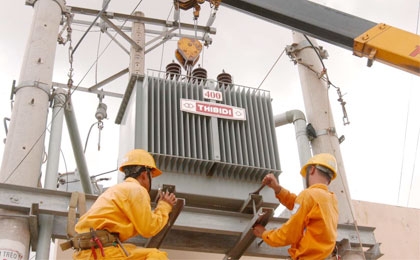Powering up market trial
 |
| illustration photo - source EVN |
Under current regulations, 83 power businesses with an annual production capacity of over 30 megawatts per year are eligible to participate in the competitive power market to win the right for selling power to the national power system.
However, multi-purpose power plants such as Hoa Binh, Yaly and Tri An and those built under the build-operate-transfer (BOT) investment model will not be required to join the race to procure the right for selling power to the national system since their power is bought directly by Electricity of Vietnam.
That is because multi-purpose power plants have to handle salinity prevention and flood releases so they win the exemption, while BOT power plants such as Phu My 2.2 and Phu My 3 had inked 25 year power supply contracts with EVN.
Many concerns exist in the lead to competitive power market test operation from July.
General director of Nhon Trach 2 Power Joint Stock Company Hoang Xuan Quoc voiced concerns over how to include the cost of establishing an information system for power offers in a competitive power market.
“Information transparency is essential to ensure the money flows contributed by power consumers will come to the hands of power generators,” Quoc said.
Quoc has reason to be anxious because EVN is a big debtor. It reportedly owed around VND5 trillion ($241.5 million) to PetroVietnam’s power firms and about VND1.5 trillion ($72.4 million) to Vinacomin’s power plants.
EVN’s financial distress stemmed from the fact that current power selling price is still lower than production costs.
To help EVN ease financial burdens and create a healthy power market, the Vietnamese government green-lighted EVN to set power cost under market rules from June 1, 2011.
Under competitive power market’s proposed scheme, in the first year of joining the market, power generators still have 95 per cent of the power volumes in the contracts bought up by EVN and have to offer only 5-10 per cent of the power volume for sale in the competitive power market. The offer volume will increase in the following years and must not less than 60 per cent of power plants’ annual power production, depending on their specific types.
A competitive power market within EVN was first put on trial from 2004-2005 with eight businesses participating. Initially, these businesses offered very competitive pricing terms. However, shortly after that the power price quickly rose to reach the set ceiling level as the supply far below the demand. The competitive power market then quickly collapsed.
What the stars mean:
★ Poor ★ ★ Promising ★★★ Good ★★★★ Very good ★★★★★ Exceptional
Related Contents
Latest News
More News
- Three-way partnership unveiled to ease financing at Hong Hac City (December 24, 2025 | 14:13)
- PM orders investment model for North–South high-speed rail (December 22, 2025 | 17:43)
- First members of Danang International Finance Centre revealed (December 22, 2025 | 17:39)
- Securing capital and efficiency for Vietnam’s 2026-2030 growth ambitions (December 17, 2025 | 10:00)
- Driving double-digit growth through green and circular transformation in Vietnam (December 17, 2025 | 09:00)
- Vietnam bucking trend in the global M&A landscape (December 16, 2025 | 14:20)
- Vietnam’s green transition demands collective financial action (December 15, 2025 | 12:00)
- VIR workshop highlights capital and policy for sustainable development (December 15, 2025 | 11:00)
- National Assembly approves pilot mechanisms to accelerate major projects in Hanoi (December 12, 2025 | 11:29)
- Vietnam eases policy approval requirements, simplifies foreign and outbound investments (December 11, 2025 | 17:53)

 Tag:
Tag:



















 Mobile Version
Mobile Version